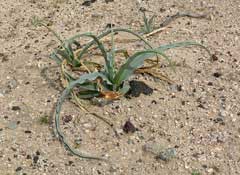 |
|
|
 |
| http://commons.wikimedia.org/wiki/User:Stan_Shebs |
Translate this page:
Summary
Physical Characteristics

 Hesperocallis undulata is a BULB growing to 0.3 m (1ft) by 0.2 m (0ft 8in).
Hesperocallis undulata is a BULB growing to 0.3 m (1ft) by 0.2 m (0ft 8in).
See above for USDA hardiness. It is hardy to UK zone 9. It is in flower from February to March. The species is hermaphrodite (has both male and female organs) and is pollinated by Insects.
Suitable for: light (sandy) and medium (loamy) soils and prefers well-drained soil. Suitable pH: mildly acid, neutral and basic (mildly alkaline) soils. It cannot grow in the shade. It prefers dry or moist soil and can tolerate drought.
UK Hardiness Map
US Hardiness Map
Synonyms
Plant Habitats
Cultivated Beds; South Wall. By. West Wall. By.
Edible Uses
Edible Parts: Root
Edible Uses:
Bulb - raw or cooked[2, 71, 161, 177, 257]. A garlic flavour[270]. The bulbs can be baked or boiled[257]. Quite large, the bulb is up to 5cm in diameter[71] and is found up to 50cm below soil level[245].
References More on Edible Uses
Medicinal Uses
Plants For A Future can not take any responsibility for any adverse effects from the use of plants. Always seek advice from a professional before using a plant medicinally.
None known
References More on Medicinal Uses
The Bookshop: Edible Plant Books
Our Latest books on Perennial Plants For Food Forests and Permaculture Gardens in paperback or digital formats.

Edible Tropical Plants
Food Forest Plants for Hotter Conditions: 250+ Plants For Tropical Food Forests & Permaculture Gardens.
More

Edible Temperate Plants
Plants for Your Food Forest: 500 Plants for Temperate Food Forests & Permaculture Gardens.
More

More Books
PFAF have eight books available in paperback and digital formats. Browse the shop for more information.
Shop Now
Other Uses
References More on Other Uses
Cultivation details
Requires a very well-drained soil in a sunny position[200]. Plants are intolerant of temperatures below freezing, especially if this is coupled with wetness[200]. The bulbs like plenty of moisture when in growth in the spring[188] but must be kept dry when they are dormant[200]. This species is not very hardy in Britain, it is best grown in a cold greenhouse or treated as a half-hardy annual[1], though they can succeed outdoors in very sheltered parts of south-west Britain[245]. Plants are very difficult to induce into flower in Britain and are best grown in a greenhouse in almost pure sand with some leafmold. Water should be withheld in the summer[42]. The flowers open in the evening and scent the air around them[245]. Bulbs are often found at a great depth in the soil[200].
References Carbon Farming Information and Carbon Sequestration Information
Temperature Converter
Type a value in the Celsius field to convert the value to Fahrenheit:
Fahrenheit:
The PFAF Bookshop
Plants For A Future have a number of books available in paperback and digital form. Book titles include Edible Plants, Edible Perennials, Edible Trees,Edible Shrubs, Woodland Gardening, and Temperate Food Forest Plants. Our new book is Food Forest Plants For Hotter Conditions (Tropical and Sub-Tropical).
Shop Now
Plant Propagation
Seed - sow in late winter or as soon as ripe in a deep pot in a very free draining compost in a greenhouse. Sow the seed thinly so that it does not have to be pricked out, and grow the young seedlings on without disturbance for their first 2 years - give them very little water during their dormant period, merely making sure that the compost does not dry out completely. Divide the young bulbs up into individual deep pots when they have completed their second growing season and grow them on in the greenhouse for at least another year before planting them out during their dormant period.
Other Names
If available other names are mentioned here
Native Range
Coming Soon
Weed Potential
Right plant wrong place. We are currently updating this section.
Please note that a plant may be invasive in one area but may not in your area so it's worth checking.
Conservation Status
IUCN Red List of Threatened Plants Status :

Growth: S = slow M = medium F = fast. Soil: L = light (sandy) M = medium H = heavy (clay). pH: A = acid N = neutral B = basic (alkaline). Shade: F = full shade S = semi-shade N = no shade. Moisture: D = dry M = Moist We = wet Wa = water.
Now available:
Food Forest Plants for Mediterranean Conditions
350+ Perennial Plants For Mediterranean and Drier Food Forests and Permaculture Gardens.
[Paperback and eBook]
This is the third in Plants For A Future's series of plant guides for food forests tailored to
specific climate zones. Following volumes on temperate and tropical ecosystems, this book focuses
on species suited to Mediterranean conditions—regions with hot, dry summers and cool, wet winters,
often facing the added challenge of climate change.
Read More
Expert comment
Author
A.Gray.
Botanical References
71200270
Links / References
For a list of references used on this page please go here
Readers comment
| Add a comment |
|
If you have important information about this plant that may help other users please add a comment or link below. Only comments or links that are felt to be directly relevant to a plant will be included. If you think a comment/link or information contained on this page is inaccurate or misleading we would welcome your feedback at [email protected]. If you have questions about a plant please use the Forum on this website as we do not have the resources to answer questions ourselves.
* Please note: the comments by website users are not necessarily those held by PFAF and may give misleading or inaccurate information.
To leave a comment please Register or login here All comments need to be approved so will not appear immediately.
|
Subject : Hesperocallis undulata
|
|
|
|